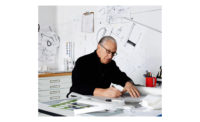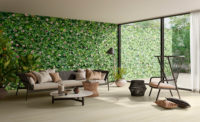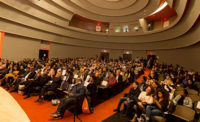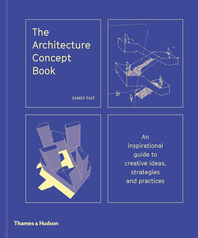The Gensler Effect: Does the Firm Have a Midas Touch in Product Design?

Gensler’s co-director of product development Brandon Larcom with Andy Sears, vice president of Structureworks Fabrication, one of the firm’s design partners.
Photo © Kelly Beamon
Architects & Firms
At a time when architect-led product design is enjoying special attention, Gensler’s collaborations are unique, largely because they begin as project-specific solutions and then lead to mass-produced items that effect the marketplace for everyone. The firm’s partnerships seem to be driving new offerings from the manufacturers of everything from desks and seating to lighting and flooring. Considering their core business is buildings and interiors, this strategy warrants a look. RECORD asked Gensler’s co-director of product development Brandon Larcom to explain why it works.
It seems unusual for architects to steer product manufacturers in the way Gensler’s collaborations seem to. What is the benefit to companies?
Gensler's global practice allows us to see the market for building products and furnishings in a unique way.
How many design partners do you have now?
There are currently 75 partners, 300 products.

A Structureworks Fabrication worker in the process of routing parts for the pergola, Gensler had helped them reimagine for use as office furniture.
Photo © Courtesy of Structureworks
Gensler chooses the companies it partners with, not the other way around. Perhaps that’s due to its size—48 offices in 14 countries with roughly six thousand employees. Manufacturer must view that global workforce as a huge customer base.
Yes. But as the world’s largest research-based architecture and design firm, we also have the ability to forecast trends and identify gaps in the marketplace. That a benefit for them.
What are some of your most noteworthy collaborations?
Some of our transformative partnerships include designing conference tables and case goods with Halcon, sustainable flooring with Mohawk Group, de-mountable glass systems with Muraflex, and adaptable desking systems with Fantoni. There’s also senior-living seating with The New Traditionalists, executive desking with IOC, open workplace seating with Stylex, ergonomic conference seating with Humanscale, and lighting systems with Artemide.
From that list, Gensler seems to be influencing nearly every product category.
We’re pushing forward on products that are redefining various markets.

Structureworks Fabrication workers is in the process of assembling a pergola wall, in line with the product’s new application in offices.
Photo © Courtesy of Structureworks
You recently redefined the pergola for the workplace. What prompted that?
Throughout the firm, we’ve noticed a trend in office environments that are no longer being tied solely to indoor spaces. New zoning ordinances across the nation allow for the conversion of rooftops into work spaces. Productivity is no longer associated with sitting at a desk. A more adaptable workforce is seeking flexibility and broader amenities.
But the why pergolas and not, say, acoustic partitions?
The idea of a modular design, an all-inclusive experience was the driving factor. And Structureworks is the largest pergola manufacturer in the U.S. Naturally, when we began reimagining the outdoor experience, we sought to partner dedicated to reshaping their marketplace.

A Structureworks welder finishes a screen, an option in the modular design Gensler envisioned when it approached the company.
Photo © Courtesy of Structureworks
This story was featured in Material World, Architectural Record’s products-focused newsletter. Subscribe today!







